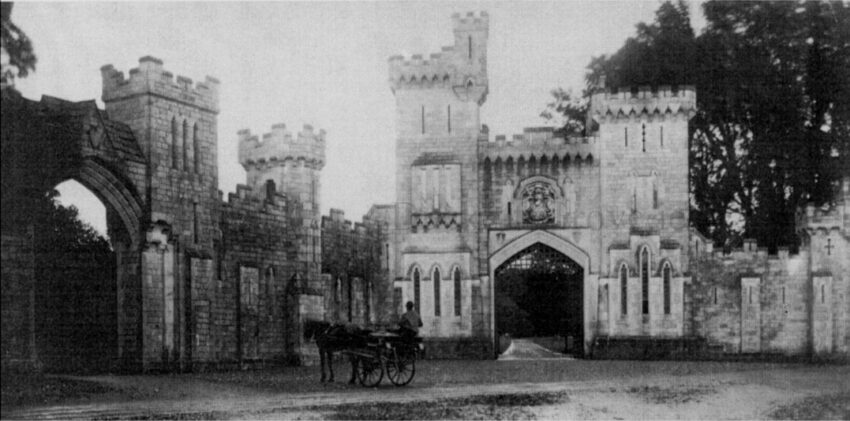Gate Lodges
Two gate lodges served Duckett’s Grove up to the mid 1800s. Chain Lodge located north of Duckett’s Grove and Gamekeepers Lodge to the south-west.
As the wealth of the Duckett’s grew, so did the grandure of the Demense. The Duckett Country house was extended by British born Architect Thomas A. Cobden at the request of John Dawson Duckett (1) circa 1825 at which stage the Gothic style mantle was added including the profound ornamentation, arches, turrets, crenellations and an octagonal viewing tower to the north. In circa 1845, the Gothic mansion was further extended. This extension was designed by John McDuff Derick Architect from Ballymote, Co. Sligo who added the granite ashlar viewing tower on an octagonal plan to the south, turretts, entrance screens and stable complex to the rear.
Two further gate lodges were also added at this time, The Iron House to the south/south-east and The Towers to the south-west. By the mid 1800s there were four gate lodges with extensive lengthy avenues lined by native trees and woodlands served Duckett’s Grove mansion, which was considered to be one of the finest Gothic mansions in Europe at that time. The four gate lodges are known locally as, Chain Lodge, Gamekeepers Lodge, The Iron House and The Towers.
The Gamekeepers Lodge
The Gamekeepers Lodge, served as the main gate lodge from the south-west up to the mid 1800s, and until the development of The Towers Gate Lodge was completed. The Gamekeepers Lodge served two avenues to Duckett’s Grove, one extending east towards the townsland of Greenane, and the other extending north, then north-east to a point where both avenues cross at a juncture known locally as Walshes Corner, and where the north/north east avenue extended to the rear of Duckett’s Grove. The eastern avenue from the Gamekeepers Lodge continued north to the front of the mansion. On completion of The Towers Gate Lodge, the main avenue from The Towers Gate Lodge merged with the eastern avenue of the Gamekeepers Lodge, making the eastern avenue of the Gamekeepers Lodge almost redundant. The Gamekeepers Lodge is located in the townsland of Rainestown, and while a small extension to the property has been erected, The Gamekeepers Lodge retains much of its original features and character, including its diagonally-set chimney stacks which are vaguely Tudor in style still exists today and is currently in private ownership.
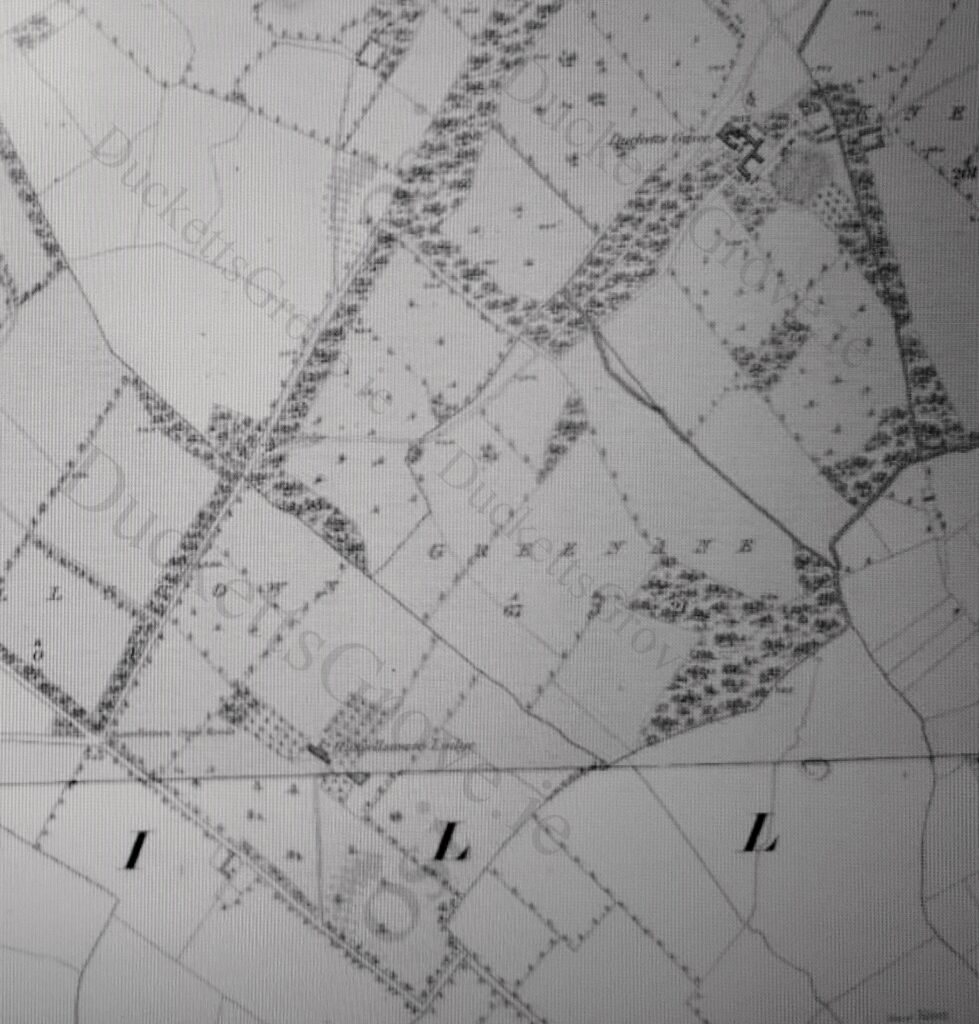
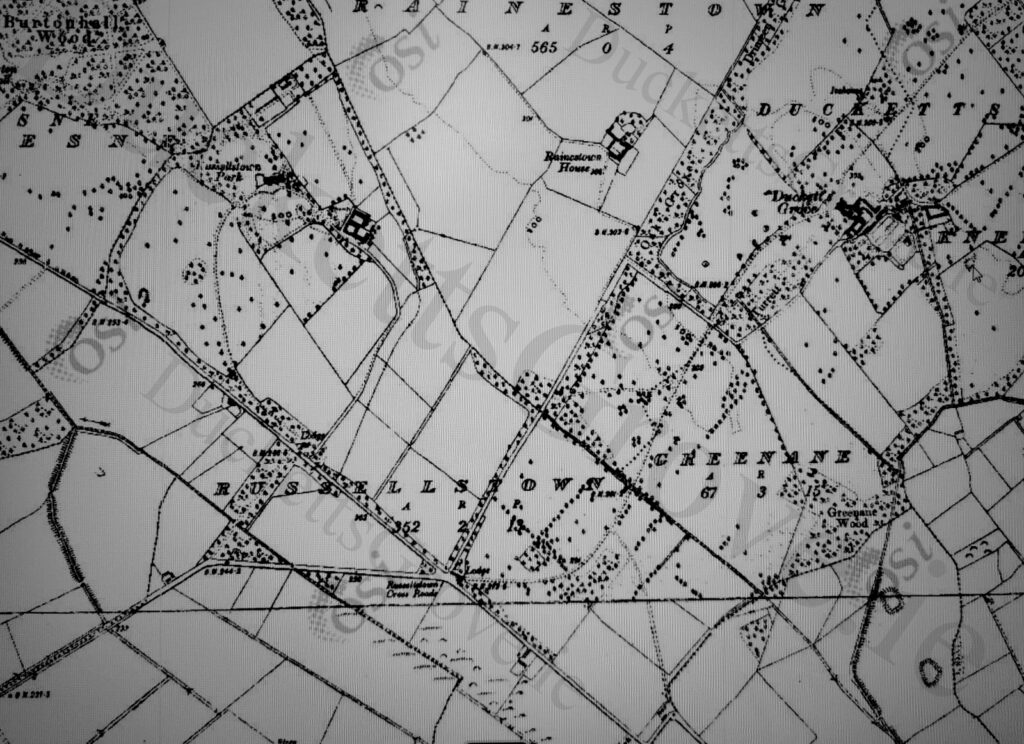
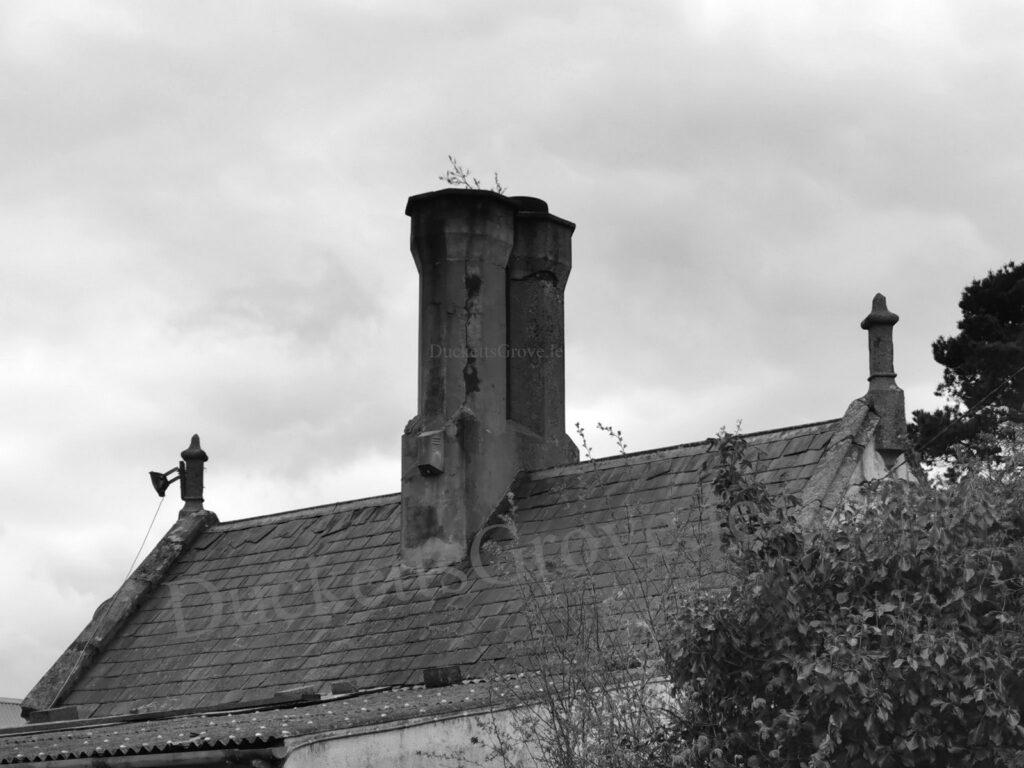
The Towers Gate Lodge
The Towers was designed by Sligo born Architect, John MacDuff Derick (1810-1859). The Towers Gate Lodge was built circa 1845 and served as the main entrance to Duckett’s Grove from that time. It is one of the most elaborate castellated gate lodges in Ireland of considerable architectural importance. It comprises of two centre towers with crenellations, lancet and mullioned windows, and has two impressive and empowering archways with two distinct avenues.
The left archway was used as the workers and deliveries entrance which was secured by the Gamekeepers Lodge closer to the mansion. To the left of the workers and deliveries entrance, a small arched gateway contains a small crest with a French inscription, “Je Veux Le Droit” meaning “I want the right”, which refers to “the right” with regards to justice and the law.
The centre archway featured a portcullis and over it, an impressive Duckett family coat of arms carved between the two towers contain a Latin inscription ‘Spectemur Agendo’ meaning ‘Let us be Judged by our Acts’. This central archway served the Duckett family and their Royal and Gentry visitors guarded with a Portcullis and Gatekeeper, served an extensive lengthy avenue lined by native trees and woodland creating a sence of security and anticipation prior to arrival at a very elaborate Gothic mansion.
The builder quotes the Carlow Sentinel describing the ‘new buildings’, “The mansion is said to belong to a transition period between the thirteenth and fourteenth centuries. The style is castellated domestic. It consists of a centre and wings, – the centre, composed of the principal gateway, with lodges on either side, in flanking towers to the gateway. These towers are of unequal height – the one being fifty, and the other forty-three feet – the taller tower having a characteristic spiral stair leading to apartments above, which are fireproof. By the staircase, which is continuous, there is an ascent to a level flat or terrace of solid masonry, composed of Carlow flags with drips, after the manner of Roslyn Castle. The pile of the building is of irregular outline in plan, covering an extent of about two hundred and forty feet. The design is by Mr. J.M. Derrick [sic], and the contractors are Messr. Kelly and Kinsella, who have been occupied about two years in the work.”
(drips: hooded mould or dripstone – an external moulded projection from a wall over an opening to relieve rainwater, introduced into architecture in the Romanesque and Gothic period).
Following the sale and division of the estate in the 1920s, The Towers Gate Lodge was extended at the rear and converted to a private residence and public house/lounge bar which remained open until the mid 1990s. During that time many Irish showbands and singers including “The Indians” and the late Joe Dolan entertained many people from near and far. Following the sale of The Towers as a public house in the 1990s, the lounge bar extension, the front steps and doorway was removed. The Towers Gate Lodge remains in private ownership and is a protected structure located at Russellstown Cross, Palatine, Co. Carlow on the L1009.
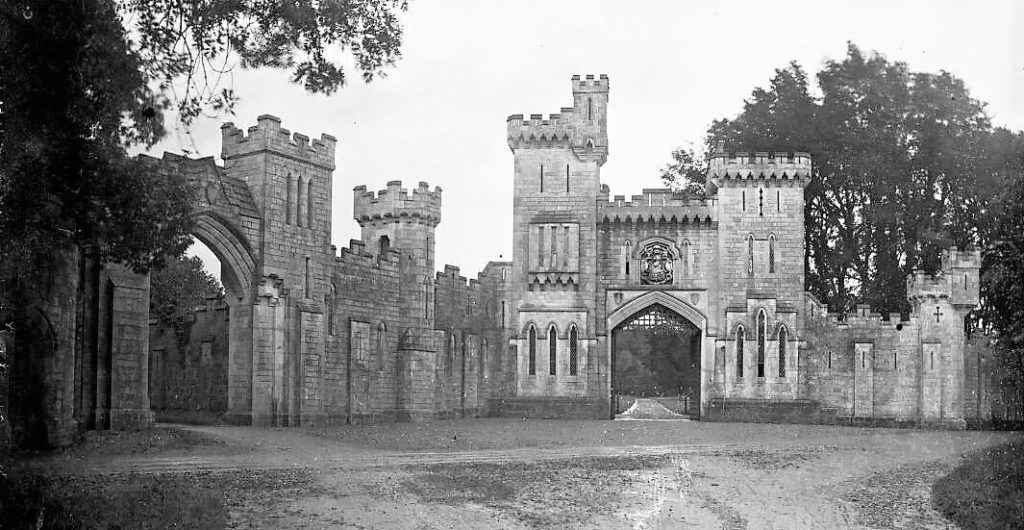
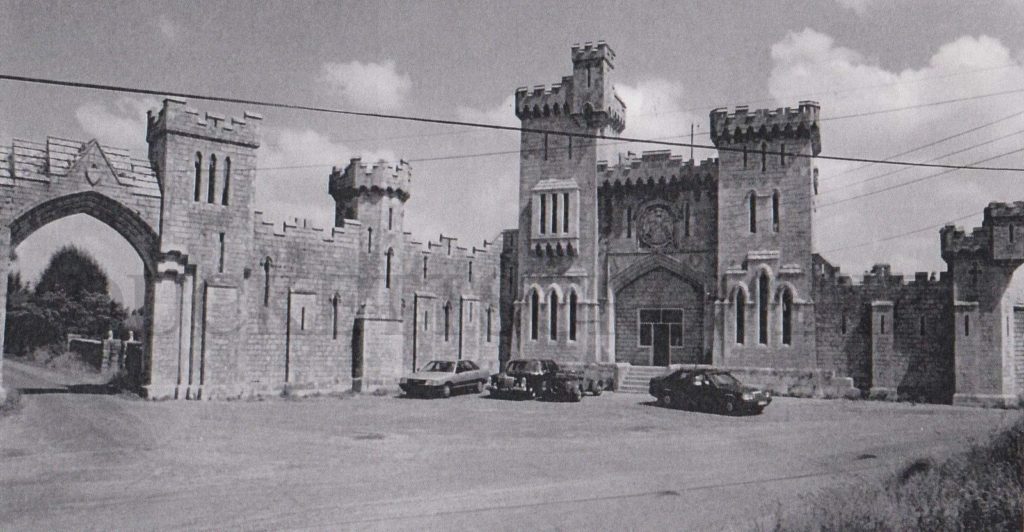
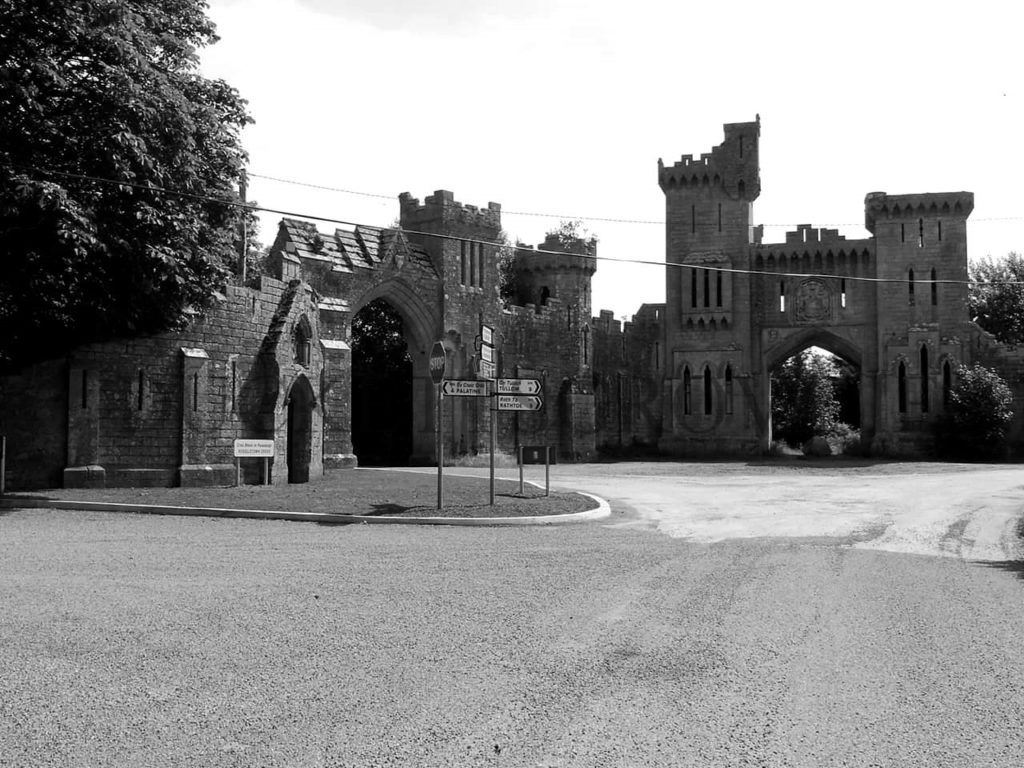
Chain Lodge
Chain Lodge is the second largest of the gate lodges of Duckett’s Grove and serves as the northern entrance to Duckett’s Grove. Chain Lodge has been extended in recent years with two small porches added, one to the north and one to the east. Chain Lodge is currently in private ownership and located on the R418 close to the Carlow/Kildare border.
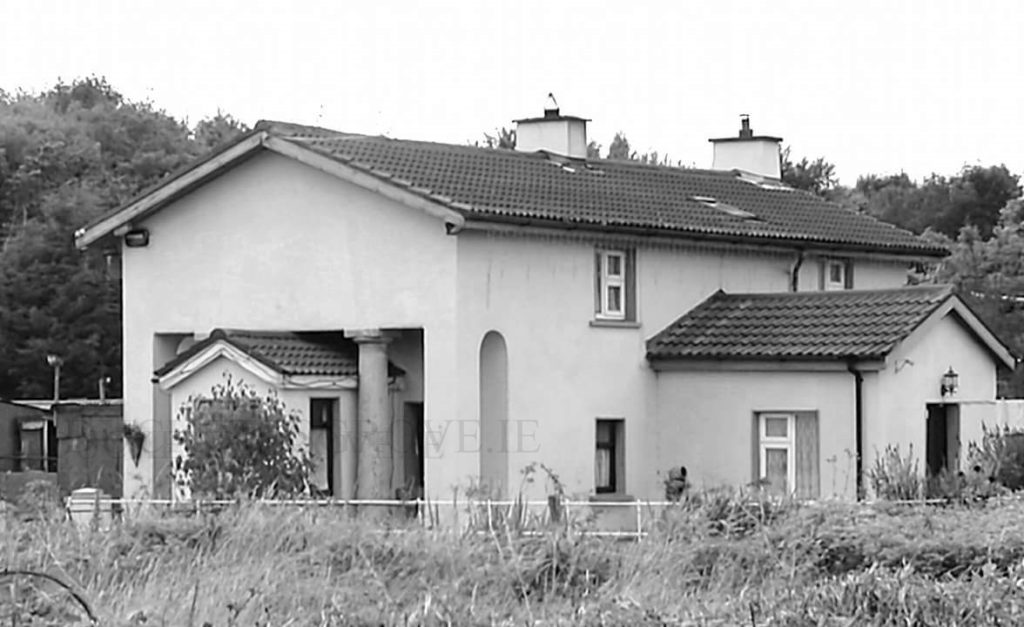
The Iron House
The Iron House served the south/south eastern entrance to Duckett’s Grove. This gate lodge, made of galvanised corrugated metal, was ornate in character and of gothic design with decorative entrance railings and gates. The Iron House was in private ownership before it was demolished in the 1980’s. It’s last resident was John Byrne, cousin of John Sweeney of Kneestown, Duckett’s Grove. The Iron House was located on the L1009 close to Friarstown Cross.
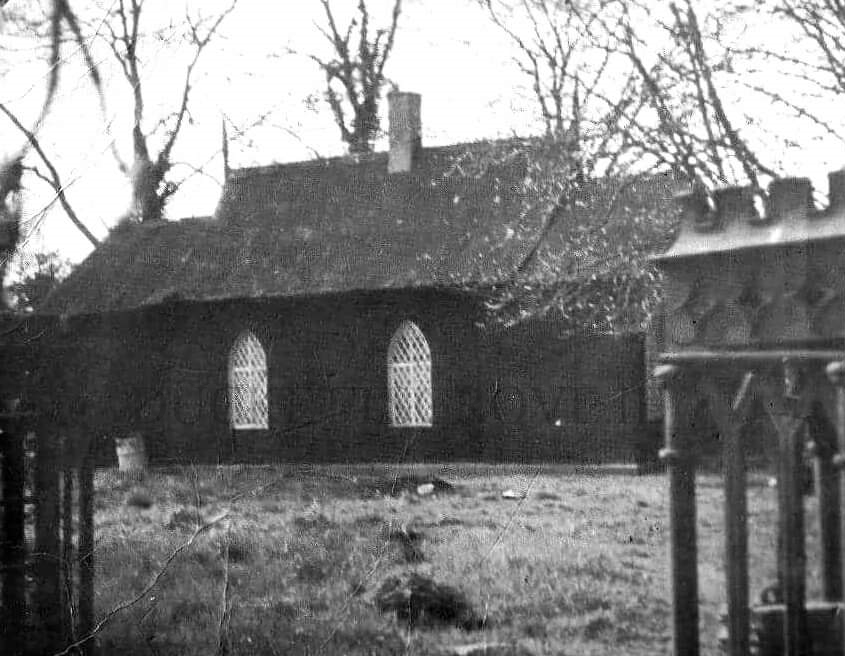
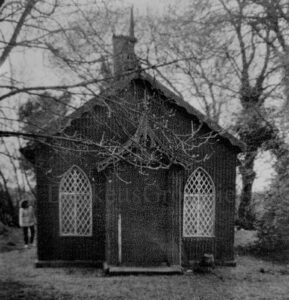
The History of Gate Lodges & The Gatekeeper:
Gate Lodges
Gates to castles, monasteries and cities had existed for centuries, but the small lodge at the entrance to the country mansion was a trend in the 18th and 19th century. The gates with their lodges were initially built to retain animals and at the same time to prevent unwanted guests or intruders. Within the following 150 years gate lodges changed from their initial function to a status statement of grandeur and wealth. Landowners and gentry expressed their wealth, power and authority by having a strong visual statement at the main entrance leading to the ‘big house’. This expression was carried through by exceptional workmanship used on main entrances to these estates, with the intent of creating a statement and good impression to the visitor before arriving at the ‘big house’.
The style of the gate lodges changed over the years from a classical style in the 18th century to more decorative structures in the 19th century. This inspiration and change was due to the romantic movement. Gate lodges were built in a vast range of different architectural styles ranging from simplistic styles such as ‘The Iron House’ gate lodge of Duckett’s Grove to the gothic “Towers’ gate lodge which still exists today. This was the beginning of a new style of gate lodge and a new career in the gatekeeper or porter.
Traditionally castles and gentry estates required someone to guard their entrance gates from uninvited guests or intruders and so a shelter was required for the gate keepers.
As the manor houses in the 16th century developed, they were surrounded by a wall for protection, therefore, they also required a gate lodge. They started as simple wooden buildings but over time they became more decorative and aesthetically pleasing to impress visitors and to gain respect. The gate lodge was a large structure usually with the family coat of arms and other sculptures used as decoration. This can still be seen on the front façade of ‘The Towers’ gate lodge today which bears the Duckett Coat of Arms over the central main entrance which was used as the residential and visitor entrance.
During the Georgian period (1714 – 1830), it became fashionable to have a landscaped park in the estate grounds. At the main entrance to the walled park, a gate lodge was usually built or a matching pair for symmetry, a common requirement during the Georgian period. A large demesne usually had more than one entrance which provided opportunities for architectural variations in gateways and lodges. Duckett’s Grove estate consisted of three gate lodges detailed below.
Throughout the Georgian period, appearances were very important, therefore, the entrance and avenue played a significant role as an introduction to the main event, which was the ‘big house’. Duckett’s Grove was no different, with native woodlands and statues lining the avenue from ‘The Towers’ gate lodge to the ‘big house’. Aimed at visitors, the gate lodge was often an indication of the style of the big house, or sometimes it was a complete contrast. Occasionally a lodge was built across the road from the entrance into the estate to advocate that the proprietor owned land on both sides of the road. Again, ‘The Towers’ gate lodge is a fine example of this with the central entrance used for residents and visitors, and the entrance to the left used for goods, deliveries and workers. Visitors were often made aware of the ‘big house’, even before reaching the gates, due to trees planted behind the stone walls of the estate which created a change in the landscape.
A gate lodge was deliberately designed as an architectural introduction of what was to follow. The vision of the lodge and avenue leading to the main house included the full pictorial experience. The Rural Residences (1818) highlights that ‘the park gate was built to catch the attention of the traveller, for the entrance of a property effecting the earliest impression on the mind of a visitor, it is of some importance that it should be of the favourable kind’. This provided great opportunities for architectural experimentations. Gate lodges were built in a vast range of different styles including Classical and Gothic. Most of these lodges mirrored the architecture of the main residence until the nineteenth century when it became more fashionable for owners to use adventurous designs and styles.
The Gatekeeper
The interior of the gate lodge was generally very small with only one or two rooms to accommodate the gatekeeper. It was very important that the position of gate keeper was assigned to dependable person, for example a faithful attendant such as a retired butler. And there is evidence that the position was sometimes passed on from one generation to the next. It was essential that they were vigilant; in permanent attendance; experienced enough to monitor visitors and recognise who they should allow through the gates of the estate. The position suited usually suited a retired servant. The estate always had the worry that the gate keeper might become too complacent, so they were encouraged to keep garden in the immediate vicinity of the gate lodge clean and tidy.
The State saw a dramatic social reformation, to the detriment of domestic buildings and the ‘big house’. The tradition of gate lodge buildings mainly continued as a program of hospital-building in the country.
Today, the gate lodge is considered by many as an important part of Irish heritage. They provide historical evidence of the past and in particularly the architectural designs, how and why the lodges were built and the social structure of society during the 18th and 19th centuries. Unfortunately most of the gate lodges were left abandoned as they were no longer required in the 20th century. Thankfully, some gate lodges such as Russellstown Park gate lodge and Duckett’s Grove northern gate lodge have been preserved and are still lived in today. It is with great hope that more gate lodges across the country will be restored, preserved and lived in to bring life back to these beautiful structures and to the communities in which they are nestled and as a reminder and a symbol of our invaluable heritage.
‘The History of Gate Lodges & The Gatekeeper’:- Source of reference for some text courtesy of Oifig na nOibreacha Poiblí (Office of Public Works).
Article by J. Doyle – Founder, Owner and Administrator of DuckettsGrove.ie
